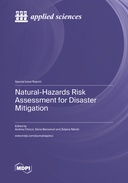Explore

Natural-Hazards Risk Assessment for Disaster Mitigation
0 Ungluers have
Faved this Work
Login to Fave
Knowledge and awareness of the risks generated by natural hazards are essential requirements for the enhancement of communities' resilience to disasters. United Nations directives have recently pointed out the necessity of undertaking actions aimed at anticipating, managing, and mitigating disaster risks to reduce their economic and social impact and protect the health, socioeconomic assets, cultural heritage, and ecosystems of communities and countries. While the increasing occurrence of disasters caused by meteorological events, such as floods, storms, and droughts, can be directly ascribed to the consequence of climate change, disasters induced by earthquakes and tsunamis are increasing even if their frequency of occurrence is historically unchanged. This Special Issue addresses concepts, methods, and predictive methodologies for assessing natural hazard risks. It presents fifteen articles focusing on the single-risk assessment of a broad range of natural hazards, such as earthquakes, river/sea floods, meteotsunamis, tornados, hydrological and meteorological drought, liquefaction, as well as on multirisk assessment in the presence of multiple hazards. The adopted methodologies rely on (a) quantitative, semi-quantitative, and qualitative methods for the assessment of the risks related to natural hazards; (b) risk analysis at different scales; (c) multi-hazard risk assessment techniques; (d) real-time hazard monitoring and warning systems; (e) disaster mitigation strategies; and (f) risk management and emergency planning on multiple scales.
This book is included in DOAB.
Why read this book? Have your say.
You must be logged in to comment.
Rights Information
Are you the author or publisher of this work? If so, you can claim it as yours by registering as an Unglue.it rights holder.Downloads
This work has been downloaded 83 times via unglue.it ebook links.
- 83 - pdf (CC BY) at Unglue.it.
Keywords
- Adriatic Sea
- AHP
- ArcGIS
- barometric pressure
- bayesian
- catastrophe model
- Climate Change
- climatology
- coastal flooding
- damage index
- Database
- digital elevation model
- drought SDI
- earthquake
- EC-Earth GCM
- Flood
- flood cause of loss
- flood insurance
- flood risk
- Gaussian process regression
- geographic information system
- geophysical surveying
- geotechnical characterization
- GIS
- Greece
- hazard assessment
- History of engineering & technology
- HURDAT
- hydraulic risk
- index of seismic risk
- lateral displacement
- linkage
- liquefaction
- Machine learning
- masonry buildings
- meteotsunami
- mobile application
- multi hazard
- multi-criteria decision-making
- multi-hazard risk assessment
- multi-hazards
- Multiple-criteria decision analysis
- n/a
- Natural disasters
- NFIP claims
- peak ground acceleration
- principal component analysis
- PROMETHEE algorithm
- PROMETHEE method
- propagation
- pushover
- pushover analysis
- real-time warning system
- reinforced-concrete
- Risk assessment
- river terraces
- seismic risk
- Seismic Risk Assessment
- Seismic tomography
- sensitivity analysis
- SPI
- target displacement
- Technology, engineering, agriculture
- Technology: general issues
- The environment
- Tides
- Tornadoes
- tsunami
- vulnerability index
- WebApp
- wind-generated waves
- WRF-ARW
Links
DOI: 10.3390/books978-3-0365-8016-6Editions

